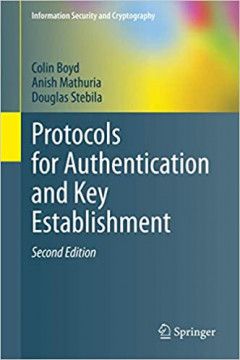Filter by

Implementasi sistem passwordless dan multi factor authentication (MFA) untuk …
Abstrak: Dalam mengikuti perkembangan teknologi, kebutuhan akan layanan juga semakin meningkat. Layanan ini biasanya memerlukan autentikasi menggunakan username dan password. Namun, penggunaan password memiliki sejumlah masalah penting. Selain rentan terhadap serangan brute force, dictionary attack, dan shoulder surfing, banyak pengguna juga cenderung ceroboh dalam memanajemen password mereka…
- Edition
- --
- ISBN/ISSN
- --
- Collation
- xvii + 106 halaman
- Series Title
- --
- Call Number
- 2023 HEN i

Protocols for authentication and key establishment
This book is the most comprehensive and integrated treatment of the protocols required for authentication and key establishment. In a clear, uniform presentation the authors classify most protocols in terms of their properties and resource requirements, and describe all the main attack types, so the reader can quickly evaluate protocols for particular applications. In this edition the author…
- Edition
- 2nd Edition
- ISBN/ISSN
- 9783662581452
- Collation
- xxviii, 521 hlm.: ilus.; 24 cm
- Series Title
- Information Security and Cryptography
- Call Number
- 005.82 BOY p

Implementasi skema Secure Key Issuing dan skema pembagian kunci sebagai alter…
Penerapan Identity-Based Cryptography (IBC) pada Wireless Sensor Network (WSN) dianggap sesuai karena pada IBC tidak terdapat proses sertifikasi kunci publik seperti yang ada pada Public Key Infrastructure (PKI). Meskipun demikian, terdapat kekurangan dari penerapan IBC pada WSN yaitu permasalahan key escrow. Pada penelitian ini dilakukan implementasi skema secure key issuing milik Lee dkk. dan…
- Edition
- --
- ISBN/ISSN
- --
- Collation
- xvi, 25??????
- Series Title
- -
- Call Number
- 2021 AGU i

PKI security solutions for the Enterprise : solving HIPAA, E-Paper Act, and o…
PART 1. TRUST BASICS: INS AND OUTS OF PKI. Chapter 1. What is Trust? Chapter 2. Complexities of PKI. Chapter 3. Best Practices of PKI. Chapter 4. Selling PKI. PART 2. SOLUTIONS FOR TRUST. Chapter 5. Healthcare Solutions. Chapter 6. Financial Solutions. Chapter 7. Government Solutions. Chapter 8. Communication Solutions. Chapter 9. Other Solutions. PART 3. TRUST …
- Edition
- null
- ISBN/ISSN
- 9780471315292
- Collation
- xxiii, 307 hlm : ilus.; 24 cm
- Series Title
- --
- Call Number
- 005.82 RAI p
Algorithms and silicon architectures for public-key cryptography
Cotents: 1. Introduction 2. Background information 3. Modified montgomery modular multiplication and RSA exponentiation techniques 4. Montgomery multiplier architectures for public-key cryptosystems-camparisons and analysis 5. An improved montgomery modular inverse algorithm 6. An elliptic curve cryptographic accelerator over GF(p) 7. Public key cryptography for wireless sensor networ…
- Edition
- --
- ISBN/ISSN
- 9783639007459
- Collation
- vii, 180 hal.; ilus.; 22 cm
- Series Title
- --
- Call Number
- 005.82 MCI a

Protocols for authentication and key establishment
Table of contents: 1. A Tutorial Introduction to Authentication and Key Establishment 2. Goals for Authentication and Key Establishment 3. Protocols Using Shared Key Cryptography 4. Authentication and Key Transport Using Public Key Cryptography 5. Key Agreement Protocols 6. Conference Key Protocols 7. Password-Based Protocols A. Standards for Authentication and Key Establishment B. Sum…
- Edition
- --
- ISBN/ISSN
- 9783642077166
- Collation
- xxiv, 320 hal.; ilus.; 24 cm
- Series Title
- --
- Call Number
- 005.8 BOY p

Quantum attacks on public-key cryptosystems
CONTENTS: 1.Classic and Quantum Computation 1.1.Classical Computability Theory 1.2.Classical Complexity Theory 1.3.Quantum Information and Computation 1.4.Quantum Computability and Complexity 1.5.Conclusions, Notes, and Further Reading References 2.Quantum Attacks on IFP-Based Cryptosystems 2.1.IFP and Classical Solutions to IFP 2.2.IFP-Based Cryptography 2.3.Quantum Attack…
- Edition
- -
- ISBN/ISSN
- 9781441977212
- Collation
- viii, 207 hlm.: ilus.; 24 cm.
- Series Title
- -
- Call Number
- 005.8 SON q

Beginning cryptography with Java
Brief Contents Chapter 1: The JCA and the JCE Chapter 3: Message Digests, MACs, and HMACs Chapter 4: Asymmetric Key Cryptography Chapter 5: Object Description in Cryptography Using ASN.1 Chapter 6: Distinguished Names and Certificates Chapter 7: Certificate Revocation and Path Validation Chapter 8: Key and Certificate Management Using Keystores Chapter 9: CMS and S/MIME Chapter 10: S…
- Edition
- -
- ISBN/ISSN
- 764596330
- Collation
- xxxii, 448 hlm.; 24 cm.
- Series Title
- -
- Call Number
- 005.8 HOO b

Beginning cryptography with Java
Contents: Chapter 1: The JCA and the JCE Chapter 2: Symmetric Key Cryptography Chapter 3: Message Digests, MACs, and HMACs Chapter 4: Asymmetric Key Cryptography Chapter 5: Object Description in Cryptography Using ASN.1 Chapter 6: Distinguished Names and Certificates Chapter 7: Certificate Revocation and Path Validation Chapter 8: Key and Certificate Management Using Keystores Chap…
- Edition
- -
- ISBN/ISSN
- 9788126506262
- Collation
- xxiv, 448 hlm.; 24 cm.
- Series Title
- -
- Call Number
- 005.8 HOO b

Secure key establishment
Contents: 1 Introduction 2 Background Materials 3 A Flawed BR95 Partnership Function 4 On The Key Sharing Requirement 5 Comparison of Bellare–Rogaway and Canetti–Krawczyk Models 6 An Extension to the Bellare–Rogaway Model 7 Proof of Revised Yahalom Protocol 8 Errors in Computational Complexity Proofs for Protocols 9 On Session Key Construction 10 Complementing Computational Pro…
- Edition
- -
- ISBN/ISSN
- 9780387879680
- Collation
- xxiii, 209 hlm.; 24 cm.
- Series Title
- Advanced in information security
- Call Number
- 005.8 CHO s
 Computer Science, Information & General Works
Computer Science, Information & General Works  Philosophy & Psychology
Philosophy & Psychology  Religion
Religion  Social Sciences
Social Sciences  Language
Language  Pure Science
Pure Science  Applied Sciences
Applied Sciences  Art & Recreation
Art & Recreation  Literature
Literature  History & Geography
History & Geography